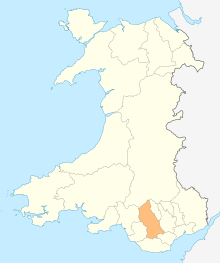Abernant, Rhondda Cynon Taf
Abernant is a small village north-east of the town of Aberdare, Rhondda Cynon Taf, Wales. Like many in the South Wales Valleys, it was once a coal-mining village.
Abernant
| |
|---|---|
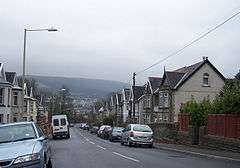 | |
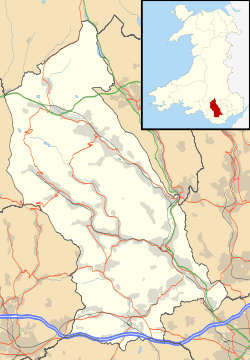 Abernant Location within Rhondda Cynon Taf | |
| Community | |
| Principal area | |
| Ceremonial county | |
| Country | Wales |
| Sovereign state | United Kingdom |
| Police | South Wales |
| Fire | South Wales |
| Ambulance | Welsh |
| UK Parliament | |
History
The village of Abernant was established in 1801, as a direct result of the founding of the Abernant Ironworks by the Tappington family.[1] In 1819 it was taken over by Rowland Fothergill, and later passed to his nephew, Richard Fothergill.[1] Among the first houses to be built were those at Little Row and Moss Place. The streets of Abernant reflect the importance of industry in the area in the 19th century, with streets named Engineer's Row, Foreman's Row and Collier's Row etc.[2]
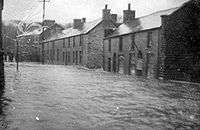
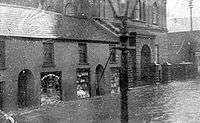
Abernant Railway Station opened in 1854 along the Vale of Neath branch line to Merthyr Tydfil. For some time the village was nicknamed The Trap, possibly because the Aberdare Iron Company Tramroad crossed the Parish Road to Abernant.[2] The Marquis of Bute maintained a small cottage hospital in the area from 1875 until World War I, which was later used as the Trap Surgery until it was demolished in 1980.[2]
A number of collieries operated in Abernant, many originally operated by the Aberdare Iron Company. The collieries were: Werfa No.1 (1846–1910); Werfa No. 2 (1879–1910); Mountain Pit (1866–1927); Blaennant Colliery (circa 1840–1927); Forge Pit (1851–1910) and River Level Colliery (circa 1840–1939).[2] In 1896, a flooding disaster occurred at River Level Colliery which killed six colliers.[2] The disaster occurred after it was inundated by water from the abandoned Ysguborwen Colliery. Although the Abedare Iron Company was responsible for the production of much coal in the Abernant area, it was never as well documented as some of the other works in the Rhondda Valley.[3]
In December 1912, the village was subject to extensive flooding, the Abernant Road in particular. In the mid-1980s, NCB reported that they intended to reopen a mine in Abernant and exploit anthracite reserves.[4]
The Abernant pit was shut down in 1988.[5]
Landmarks
Abernant House was built by James Birch, cofounder with Jeremiah Homfray of Abernant Ironworks. In 1819 the ironworks were sold and the house was passed to Rowland Fothergill and later his nephew Richard Fothergill. Richard Fothergill was responsible for adding many extensions to the original building and landscaping of the grounds.[2] On March 1, 1892, Emma Talbot of Margam founded the St Michael's Theological College but in 1907 the college moved to Llandaff, Cardiff. Since 1917 Abernant House has been used as the site of Aberdare General Hospital.[2] On September 27, 1929, a fire gutted the main building, destroying its notable interior furnishings too.[2] The hospital later reopened in April 1933, and in 1939 W M Llewellyn funded the construction of a new maternity ward.
Religion
The main active churches are:
- Bethel is a Baptist chapel opened in 1856
- St Matthew's Mission Church, Church of Wales, opened 1888
There are also defunct places of worship:
Notable people
- Stuart Cable (1970–2010), the late former drummer of the Stereophonics and broadcaster lived in Abernant for a period.
- Elaine Morgan (7 November 1920 – 12 July 2013) lived with her husband and wrote in a bungalow called Noddfa near Little Row, Abernant.
Gallery
 Abernant, c. 1900.
Abernant, c. 1900.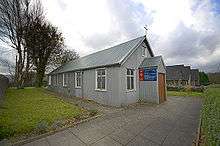 St Matthews Mission Church.
St Matthews Mission Church.
References
- Jones 1964, p. 150.
- "Abernant". Rhondda Cynon Taff Library. Archived from the original on 18 July 2011. Retrieved 7 June 2010.
- Morgannwg, Volumes 39-41. Glamorgan History Society. 1995.
- Coal age, Volume 90. McGraw-Hill. 1985.
- "Pit Closures, Year By Year". BBC News. Retrieved 12 April 2020.
- "Abernant". Rhondda Cynon Taf Library Digital Archive. Archived from the original on 3 October 2011. Retrieved 7 June 2010.
- "Glamorgan Record Office Aberdare Ecclesiastical Parish records". Archives Wales. Archived from the original on 16 July 2011. Retrieved 7 June 2010.
Bibliography
- Jones, Ieuan Gwynedd (1964). "Dr. Thomas Price and the election of 1868 in Merthyr Tydfil : a study in nonconformist politics (Part One)" (PDF). Welsh History Review. 2 (2): 147–172.CS1 maint: ref=harv (link)
External links
| Wikimedia Commons has media related to Abernant, Rhondda Cynon Taf. |
